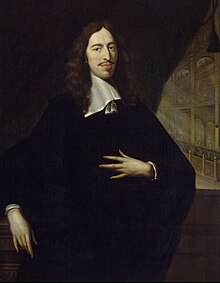| First Stadtholderless Period | |||
|---|---|---|---|
| 1650–1672 | |||
 Portrait of Johan de Witt, Grand Pensionary of Holland (by Jan Asselijn ca. 1652) | |||
| Location | Dutch Republic | ||
| Including | Dutch Golden Age Rampjaar | ||
Chronology
| |||
The First Stadtholderless Period (1650–72;[1] Dutch: Eerste Stadhouderloze Tijdperk) was the period in the history of the Dutch Republic in which the office of Stadtholder was vacant in five of the seven Dutch provinces (the provinces of Friesland and Groningen, however, retained their customary stadtholder from the cadet branch of the House of Orange). It coincided with the zenith of the Golden Age of the Republic.
The term has acquired a negative connotation in 19th-century Orangist Dutch historiography, but whether such a negative view is justified is debatable. Republicans argue that the Dutch state functioned very well under the regime of Grand Pensionary Johan de Witt, despite the fact that it was forced to fight two major wars with England, and several minor wars with other European powers. Thanks to friendly relations with France, a cessation of hostilities with Spain, and the relative weakness of other European great powers, the Republic for a while was able to play a pivotal role in the "European Concert" of nations, even imposing a pax nederlandica in the Scandinavian area. A convenient war with Portugal enabled the Dutch East India Company to take over the remnants of the Portuguese Empire in Ceylon and South India. After the end of the war with Spain in 1648, and the attendant end of the Spanish embargo on trade with the Republic that had favored the English, Dutch commerce swept everything before it, in the Iberian Peninsula, the Mediterranean Sea and the Levant, as well as in the Baltic region. Dutch industry, especially textiles, was as yet not hindered by protectionism. As a consequence, the Republic's economy enjoyed its last great economic boom.
Politically, the Staatsgezinde (Republican) faction of the ruling Dutch Regents such as Cornelis de Graeff and Andries Bicker reigned supreme. They even developed an ideological justification of republicanism (the "True Freedom") that went against the contemporary European trend of monarchical absolutism, but prefigured the "modern" political ideas that led to the American and French constitutions of the 18th century. There was a "monarchical" opposing undertow, however, from adherents of the House of Orange who wanted to restore the young Prince of Orange to the position of Stadtholder that his father, grandfather, great-uncle, and great-grandfather had held. The republicans attempted to rule this out by constitutional prohibitions, like the Act of Seclusion. But they were unsuccessful, and the Rampjaar ("Year of Disaster") of 1672 brought about the fall of the De Witt regime and the return to power of the House of Orange.
- ^ "Netherlands - The first stadtholderless period | Britannica". www.britannica.com. Retrieved 2022-08-27.